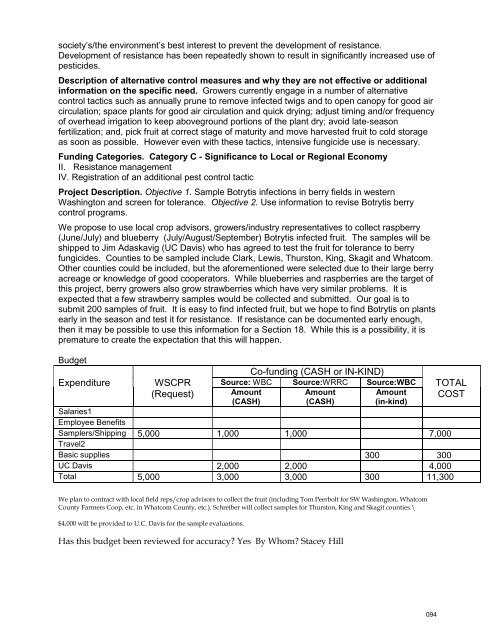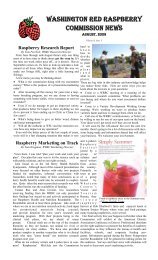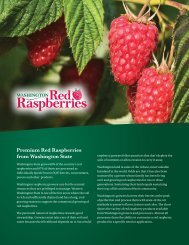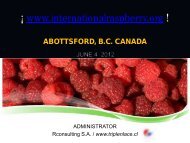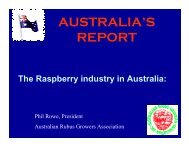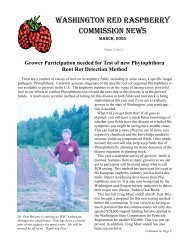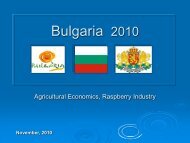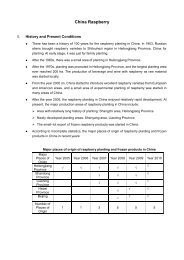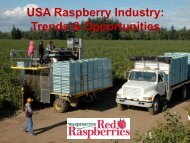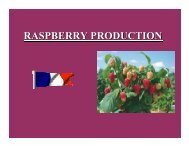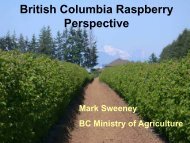2012 - Washington Red Raspberry Commission
2012 - Washington Red Raspberry Commission
2012 - Washington Red Raspberry Commission
Create successful ePaper yourself
Turn your PDF publications into a flip-book with our unique Google optimized e-Paper software.
society’s/the environment’s best interest to prevent the development of resistance.<br />
Development of resistance has been repeatedly shown to result in significantly increased use of<br />
pesticides.<br />
Description of alternative control measures and why they are not effective or additional<br />
information on the specific need. Growers currently engage in a number of alternative<br />
control tactics such as annually prune to remove infected twigs and to open canopy for good air<br />
circulation; space plants for good air circulation and quick drying; adjust timing and/or frequency<br />
of overhead irrigation to keep aboveground portions of the plant dry; avoid late-season<br />
fertilization; and, pick fruit at correct stage of maturity and move harvested fruit to cold storage<br />
as soon as possible. However even with these tactics, intensive fungicide use is necessary.<br />
Funding Categories. Category C - Significance to Local or Regional Economy<br />
II. Resistance management<br />
IV. Registration of an additional pest control tactic<br />
Project Description. Objective 1. Sample Botrytis infections in berry fields in western<br />
<strong>Washington</strong> and screen for tolerance. Objective 2. Use information to revise Botrytis berry<br />
control programs.<br />
We propose to use local crop advisors, growers/industry representatives to collect raspberry<br />
(June/July) and blueberry (July/August/September) Botrytis infected fruit. The samples will be<br />
shipped to Jim Adaskavig (UC Davis) who has agreed to test the fruit for tolerance to berry<br />
fungicides. Counties to be sampled include Clark, Lewis, Thurston, King, Skagit and Whatcom.<br />
Other counties could be included, but the aforementioned were selected due to their large berry<br />
acreage or knowledge of good cooperators. While blueberries and raspberries are the target of<br />
this project, berry growers also grow strawberries which have very similar problems. It is<br />
expected that a few strawberry samples would be collected and submitted. Our goal is to<br />
submit 200 samples of fruit. It is easy to find infected fruit, but we hope to find Botrytis on plants<br />
early in the season and test it for resistance. If resistance can be documented early enough,<br />
then it may be possible to use this information for a Section 18. While this is a possibility, it is<br />
premature to create the expectation that this will happen.<br />
Budget<br />
Expenditure<br />
WSCPR<br />
(Request)<br />
Co-funding (CASH or IN-KIND)<br />
Source: WBC Source:WRRC Source:WBC<br />
Amount<br />
Amount<br />
Amount<br />
(CASH)<br />
(CASH)<br />
(in-kind)<br />
Salaries1<br />
Employee Benefits<br />
Samplers/Shipping 5,000 1,000 1,000 7,000<br />
Travel2<br />
Basic supplies 300 300<br />
UC Davis 2,000 2,000 4,000<br />
Total 5,000 3,000 3,000 300 11,300<br />
TOTAL<br />
COST<br />
We plan to contract with local field reps/crop advisors to collect the fruit (including Tom Peerbolt for SW <strong>Washington</strong>, Whatcom<br />
County Farmers Coop, etc. in Whatcom County, etc.). Schreiber will collect samples for Thurston, King and Skagit counties.\<br />
$4,000 will be provided to U.C. Davis for the sample evaluations.<br />
Has this budget been reviewed for accuracy Yes By Whom Stacey Hill<br />
094


